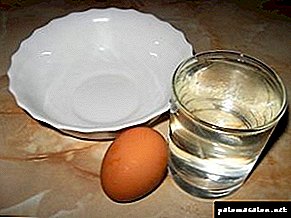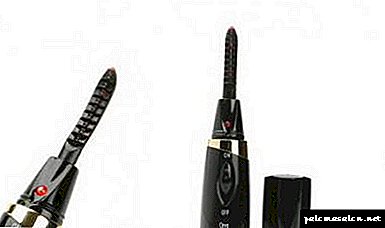
The history of hair coloring has very ancient roots. It is known for certain that in Assyria and Persia, only rich and noble hair and beard were dyed. A little later, the Romans adopted this habit from their eastern neighbors, and the almost bleached shade of hair was considered especially popular. We have reached the recipes for hair coloring in the writings of the famous roman doctor galen. Interestingly, according to these recipes, gray hair was recommended to paint with walnut decoction.
 "No matter how much the Romans fought with the barbarians, but nevertheless the northern blond women were the standard of beauty for the Romans!"
"No matter how much the Romans fought with the barbarians, but nevertheless the northern blond women were the standard of beauty for the Romans!"
But the Middle Ages did not bring to us any mention of the attempts of women to change themselves by dyeing their hair. This is understandable, since in those days cruel mores reigned and peculiar ideas of female chastity triumphed.
In the times of the Renaissance, old recipes came to life, and women could once again use natural personal care products. Blondes experienced another period of popularity.
The heyday of alchemy left an imprint on the features of women's cosmetics. So, in the book of the famous alchemist Giovanni Marinelli, the recipes for cosmetic preparations are filled with such mysticism that no modern woman would dare to touch the solution prepared in accordance with his instructions with a finger.

Later, when the red color came into fashion, women of easy behavior adopted the palm of hair coloring. Very popular was henna - dried leaves and bark of lavsonia shrubs. With henna, you can get shades from carrot to copper. Adding to the henna indigo, walnut or chamomile, received different shades. From the leaves of the shrub indigo received Basma. Undoubtedly, in those days, decent women could no longer so brightly dye their own hair, and fashion gradually changed.
The nineteenth century can rightly be called revolutionary, including in the production of cosmetics. It was then that laid the foundations of modern production of hair dye.
In 1907, the French chemist Eugene Schueller invented a dye containing salts of copper, iron, and sodium sulfate. A new patented product guaranteed the customer the desired color. To produce his own paint, Schueller created the French Society of Safe Hair Dyes. A few years later it turned into a firm "L'Oreal", cosmetic products which are well known.
 "Paints containing metal salts were used almost until the middle of our century."
"Paints containing metal salts were used almost until the middle of our century."
Currently, such paints are rarely used, although modern studies have shown that heavy metals are practically not absorbed through the hair and scalp. These paints consist of two solutions: a solution of metal salts (silver, copper, cobalt, iron) and a solution of a reducing agent. When dyeing with salt-based paints, you can get a steady color, but the tone is very sharp, unnatural. And yet - with their help, you can get only dark tones.
Modern manufacturers offer a wide range of coloring products: resistant paints, tinted shampoos and balms, hair tinting products.
Hair dye in ancient Egypt
For many centuries, the Egyptians preferred blue-black or bright red hair. As early as 4 millennia BC, henna, known to this day, contributed to this. To diversify the palette, Egyptian beauties diluted henna powder with all sorts of ingredients that could cause a panic attack in contemporaries. So, in the course was cow blood or crushed tadpoles. Hair, frightened by such inappropriate treatment, changed color at once. By the way, the Egyptians are early saddles, a genetic predisposition with which they fought with the help of blood of buffalo or black cats boiled in oil, or raven eggs. And to get black, it was enough to mix henna with an indigo plant. This recipe is still enjoyed by lovers of natural coloring.
Hair dye in ancient Rome
Here the “tician” shade of hair was very fashionable. In order to get it, local girls rubbed their hair with a sponge dipped in soap made from goat's milk and ash of a beech tree, and after hours sat in the sun.
By the way, Roman charmer women had more than a hundred recipes for coloring mixtures! Occasionally the usual fashionistas were used, and sometimes incredible ingredients: ash, shells and leaves of walnut, lime, talc, beech ash, onion peel and leeches. And the lucky girls, who have immense wealth, sprinkled gold on their heads to create the illusion of blond hair.
It was in Rome that they invented the first chemical method of dyeing hair. To become noticeably darker, the girls moistened the lead comb in vinegar and combed. The lead salts deposited on the curls had a dark shade.
Hair dye in the Renaissance
Despite the ban of the church, the girls continued to experiment with hair color and, accordingly, with dyes. In the course was all the same henna, flowers gorse, sulfur powder, soda, rhubarb, saffron, eggs, as well as the kidneys of calves.
Lead in the development of new color formulas, as usual, France. So, Margo Valois came up with her own recipe for lightening hair, which, unfortunately, did not reach us. And for coloring the curls in black, the French used the old and proven method of the Romans - lead comb in vinegar.
19th century - the time of discovery
In 1863 a substance was synthesized, known as paraphenylenediamine, which was used for dyeing tissues. Based on this chemical component, modern paint formulas were developed.
In 1867, a chemist from London (EH Tilley), teamed up with a hairdresser from Paris (Leon South), opened new horizons for women of the whole world, demonstrating a new method of lightening hair with hydrogen peroxide.
Hair dye in the 20th century
Who knows, what would we have painted now, if the unsuccessful trip of Eugene Schueller's wife to the hairdresser. The kind of lifeless strands of his beloved wife inspired the ingenious experimenter to create a synthetic dye containing salts of copper, iron, and sodium sulfate. After testing the paint on his grateful wife, Eugene began selling the dye at the hairdresser’s under the name “L’Aureale”. The paint instantly gained popularity, which enabled Eugene to expand production, open L’Oreal and continue to experiment with the color scheme. That's what love with people does!
Hair dye in the 20s
A competitor, L’Oreal, has a competitor, Mury, a company producing paints that penetrate deep into the hair, which prolonged the color fastness and painted over gray hair.
“L’Oreal” expands the horizons and publishes natural paint “Imedia”, which has a whole range of natural shades.
In Germany, too, they did not sit in one place: it occurred to the founder’s son of Wella to combine a coloring pigment with a caring agent. The paint has become more benign, which caused a storm of delight in women.
Hair dye in the 60s
The development of the cosmetics market is taking giant strides; large companies, whose specialization has nothing to do with hair dye, decide to join the general madness. So the company "Schwarzkopf" created paint "Igora Royal", which has become a real classic.
At the same time, chemists around the world are working on a formula without hydrogen peroxide, capable of painting over gray hair. There are more and more new shades, beauties of the whole world boldly use hair-dye.
Hair dye in the modern world
Now we have a great variety of formulas and dyes of various brands. Science does not stand still, so there appeared mousses, foams, balms, tinted shampoos, tonics. Girls dye their hair to cheer themselves up, without fear for the state of their hair. New formulas are enriched with useful components, amino acids, proteins, keratin and bio-additives.
Although, despite the extensive selection of modern paints and sparing formulas, many girls prefer natural dyes and return to the ancient methods of dyeing using henna and basma, onion peel, and even beets!
History of staining
Until now, there are disputes about who first and in what ancient year began to apply hair dye. What woman in a rush to change herself picked up some ingredients, mixed them and put them on her hair? we probably will never know the exact answer.
It is said that the ancient Roman women of fashion were innovators in this matter. Oh, what they just did not invent recipes, trying to turn into blondes or red! For example, sour milk was in great demand - it, according to historians, easily turned the owner of dark strands into a languid blonde.
Since blond hair was associated at that time with purity and chastity, Roman matrons, who were not particularly moral, were not limited to sour milk. Lemon juice was used to lighten hair. It was done in the following way: a wide-brimmed hat with a cut-out was taken, through which hair was pulled up and laid out over the brim of the hat. Then they were abundantly wetted with lemon juice and the girl sat for a few hours under the scorching sun, after which, if she did not fall down with a sunstroke, she went to show off her girlfriends in the color of the sun's rays!)
Instead of lemon juice, a solution of goat milk soap and beechwood ash was sometimes used. Those who did not want to use such radical mixtures gradually bleached their hair with a mixture of olive oil and white wine (this recipe, I think, is also useful!) Those who did not want to bathe in the sun for hours, did it very simply - they bought a couple of fair-haired German slaves, and made wigs out of their hair.
Do not forget about ancient Greece, women of fashion which in no way lagged behind the Roman. Generally, in ancient Greece, hairdressing was one of the most highly developed. Blondes were in fashion! The goddess Aphrodite, again, was reputed to be the owner of a shock of blond hair. In principle, all the recipes for dyeing hair came from ancient Greece, the only thing that Greek women used to paint an ancient Assyrian mixture of Chinese cinnamon and onion leek.
In ancient Egypt, the owners of black and dark blond hair were valued, which were evidence of housewifeness, decency and severity of their owner. Henna, basma and walnut shells are the alpha and omega of the fashionistas of Egypt, India and the island of Crete, and all these dyes were mixed in the most unimaginable variants, resulting in fashionable Egyptian and Indian women shining with dark hair of the most incredible shades. Well, wigs, of course, where do without them. In ancient Egypt, wigs during official ceremonies were mandatory!
Used and soot. Mixing it with vegetable fats, women covered their hair with this mixture, achieving a black color.
Redheads By the ginger always treated ambiguous. In ancient India, a red-haired woman was considered a witch with a "bad" eye, in ancient Rome - a representative of noble blood. Having spat on all sights, some women of fashion persistently achieved shades of hair the color of fire. In the course was henna, which came from ancient Persia, as well as sage, saffron, calendula, cinnamon, indigo, walnut and chamomile. The most interesting is that women of easy virtue first of all adopted the fashion for red hair! Later, a resident of Venice began to consider red almost the only noteworthy color in the world and repainted her hair in all his imaginable and unimaginable shades! To the above means added carrot juice. Titian Vecellio in his works forever imprinted red beauties! The women of Easter Island still dye their hair red, considering it to be festive and solemn.
And even later, Queen Elizabeth I completely changed the standards of world beauty with her natural hair color of amazing reddish tint and whitest skin, displacing medieval blond beauties.
All women fought with gray hair at all times. And they used for this recipes, which were brilliant both in staining resistance and originality.
In ancient Egypt, gray hair got rid of with the help of blood! Ancient Egyptian mummies (whose hair is preserved, of course)), still amaze scientists with the rich and unalloyed color of their hair. Also in Egypt, another terrific tool for combating gray hair was invented: a mixture of black bull fat and raven eggs.
History of hair dye
December 13, 2010, 00:00 | Katya Baranova

The history of hair dye goes back centuries and even millennia. Since ancient times, people, wanting to be more beautiful and follow sophisticated fashion trends, have sought to change the natural order of things.
First, access to change the color of their hair got to know. Only rich people who had a special position in society were allowed to dye their beards, mustaches and hair. The earliest references to this are in Syria and Persia. Later, fashion migrated to ancient Rome. Then blondes and blondes were held in high esteem, and, as they would say now, perhydrols. Achieved the effect of discoloration by covering the hair with a special composition, and then exposing it to the sun. And men in Babylon even rubbed gold in their heads!

Roman doctor Galen brought to us the recipes of ancient hair dye. And no wonder that the compositions were natural. For example, it was recommended to gray hair to paint over walnut decoction.
In the Middle Ages, it was not surprising to become a witch, especially if you were born red-haired, so that girls and women were very cautious about their appearance. We have not reached the recipes for hair care of the time, but I suspect that natural decoction is still used.
But the Renaissance returned the fashion of ancient Rome, then they remembered the ancient chronicles, where the recipe of hair care products is indicated. Well, honor again, of course, got the blondes. A red color came into vogue because of a genetic error. Queen Elizabeth I had bright red hair.

- Botticelli. Spring
The Baroque period, together with wigs, brought different shades of hair into fashion, from yellow to blue, and later it was considered fashionable to powder black hair to achieve a gray hair effect.
Henna and Basma. I don’t think that one of the girls will have a question about what it is and what it is eaten with. For example, I tried to dye my hair with henna in the 9th grade at school. It turned out a great chestnut hue. And the more I have never been able to get anything like that. And my sister periodically tries to get out of the red color, but returns to hell again and again. So she turned out to be sticky. And during the Renaissance period, women mixed henna with walnut decoction, chamomile, indigo and other plant components. Different shades turned out.
And y Sienna Miller There was a bad experience with henna coloring. The actress got a green tint, and by her own admission, she had to sit every evening for several weeks with a mask of tomato ketchup on her hair.

When did the first chemical formulas appear to change hair color? In times of craze for alchemy. But these louvers were so intricate and sophisticated that today you can look at them only with a smile or fear (someone closer).And then, I suspect, for want of something better, they used what was. For example, if you hold silver nitrate on your hair for the allotted time, you get a pleasant dark shade, and if you overdo it - purple. This effect has pushed scientists to create a chemical formula paint.
In 1907, the French chemist Eugene Schuller invented a dye containing salts of copper, iron and sodium sulfate. And this was the opening of the era of chemical dyes, which today hold the palm in the market for hair dyes.

In 1932, Lawrence Gelbu managed to create such a dye that his pigment penetrated into the hair.
And in 1950, a one-step hair coloring technology was created, allowing it to be used at home.
Today, hair dyes are represented in a wide range, but as if advertising companies and consultants do not admonish us, their hair will still weaken, and the following products will help to support them.



- Shampoo mask Bioecological for weak and damaged hair Capelli sfibrati lavante, Guam
- Shampoo for tired and weak hair Salvia and Argan, Melvita
- Moisturizing mask "Carrot care" for hair and scalp based on Dead Sea mud, Yes to carrots
And how do you feel about natural dyes?



